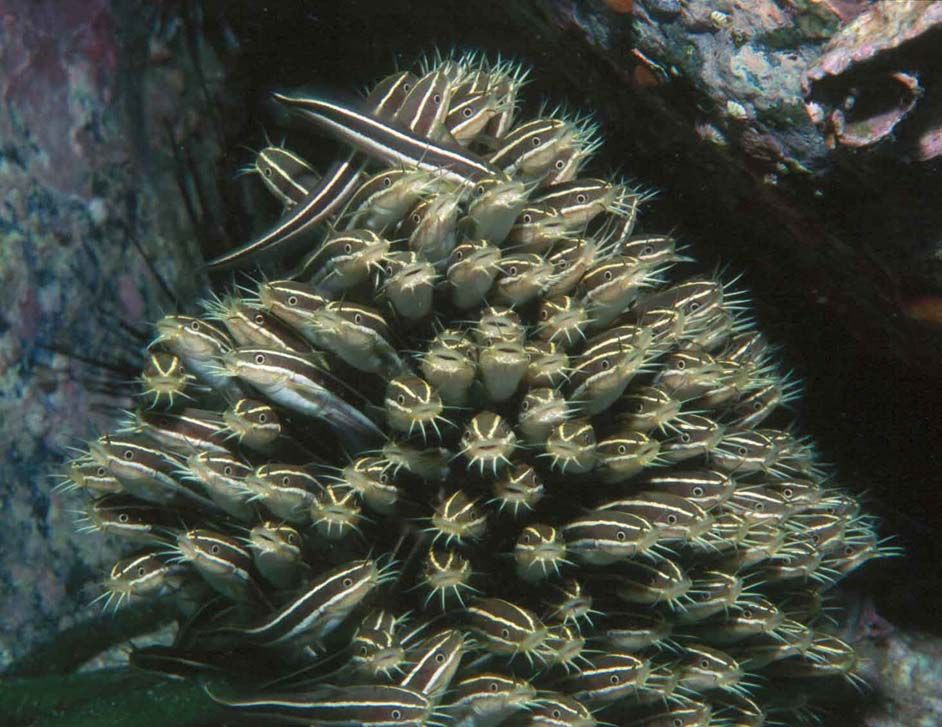This Catfish’s Whiskers Are Like Ultra-Sensitive pH Strips
Japanese sea catfish seek out worms in the pitch dark by detecting minute changes in water chemistry caused by their prey’s breathing
/https://tf-cmsv2-smithsonianmag-media.s3.amazonaws.com/filer/b7/15/b715e60b-9aea-4cc8-a0b2-8bf0c563d3c5/catfish1.jpg)
Animals have various ways of contending with pitch-black conditions. Moles can smell in stereo; bats use echolocation; and blind cave fish use their teeth to feel around in the darkness sans sight. Most of these animals also happen to be blind or nearly blind, hence the need to evolve interesting eyesight workarounds.
But at least one animal, it turns out, can traverse the light-dark divide: Japanese sea catfish. While catfish normally don’t come to mind as belonging on the list of animals-that-can-operate-in-the-dark, new research published in Science confirms that they can indeed hold their own when the lights go out. To do this, those fish turn to chemistry.
Originally, the researchers were investigating how the fish respond to various chemical taste stimuli, but while studying nerve fibers in the catfish’s whiskers they noticed that those appendages seemed to be reacting to the amount of carbon dioxide and hydrogen in the tank. When the pH fell a bit, the fibers became activated and excited.
Intrigued, the researchers decided to pursue their curiosity and see if something more was going on. The catfish, they knew, usually fed at night and preferred to eat marine worms that live in burrows. First, they measured the pH around a few captive worms over various time intervals and at various distances. When the worms breathe, they found, those organisms release carbon dioxide and hydrogen, which very slightly lowers the pH in the surrounding water. The catfish, they thought, might be detecting that change.

To find out, the team introduced a few catfish into a tank containing hidden marine worms. They made sure conditions were kept pitch black and used an infrared camera to record the predatory drama that ensued. The fish had no trouble rooting out the worms’ hiding places, the team found. Those predators would confidently approach the worms’ burrows and “suck them out.”
Next, the team decided to perform the same experiment, only this time the worms’ burrows were covered in protective netting. But even though the fish could not access the worms, they still spent a significant amount of time in their prey’s vicinity, the researchers found.
Finally, the team skipped the worms altogether and just slightly lowered various sections of the aquarium’s pH by trickling water of a different pH through a tube inserted in the aquarium. The catfish rushed to those areas and switched into “an appetitive search mode”—science speak for searches fueled by the munchies—when the hose was on, the team reports. But the fish ignored those areas when the hose was off or was pumping in seawater of the same pH as the aquarium.
In a tank that normally registered at a pH of 8.23, a change to 8.1 or 8.2 excited the fish the most, the researchers found, but a pH of 8.0 or below didn’t even register. In other words, the catfish could detect pH changes of less than 0.1 units but perhaps not larger changes, and they were very particular about how they interpreted those changes. The researchers concluded that the catfish possess an “extraordinary sensitivity” to chemical cues.
The downside to the catfish’s princess-and-the-pH-like sensors, however, is their potential vulnerability to climate change. Experts predict that ocean acidification will decrease the pH of the world’s waters, which could be bad news for the catfish. The ocean is already 30 percent more acidic today than it was in pre-industrial times, the team points out, and by the end of this century it’s is supposed to drop another 150 percent, to an average pH of 7.8.
If the catfish’s feelers really are so sensitive that they don’t work on values that stray outside of about a 0.1 pH window, then those chemical changes might impact their ability to find food. Whether or not the fish will be able to adapt to those changes, the team concludes, remains unknown.
/https://tf-cmsv2-smithsonianmag-media.s3.amazonaws.com/accounts/headshot/Rachel-Nuwer-240.jpg)
/https://tf-cmsv2-smithsonianmag-media.s3.amazonaws.com/accounts/headshot/Rachel-Nuwer-240.jpg)